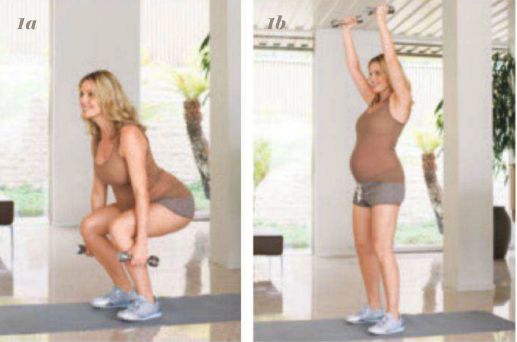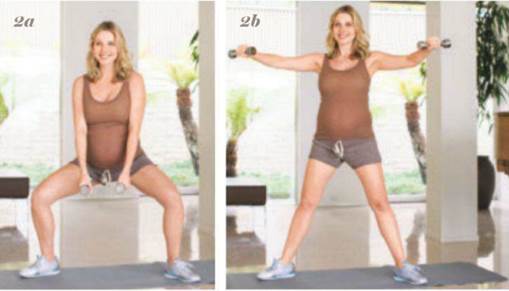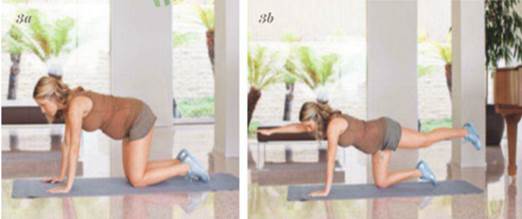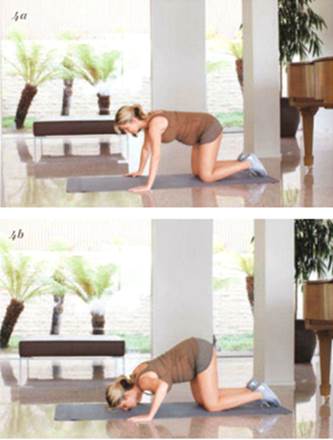Just half an hour of exercise each
day will be good for you and your baby. Here's how to overcome obstacles and
take advantage of every moment.
Between the birth classes, doctor
appointments, shopping for baby and other routines, do future mums have time to
do exercise? Actually, they do. "30 minutes is all you need for an
effective exercise", said Susan Hoffman, trainer cum expert in prenatal
fitness club Boca Raton Life Time in Boca Raton, Fla. Needing motivation? The
pregnant women who do exercise regularly will have less risk of obesity,
hypertension and weight gain, as well as have less headaches, more energy and
they are easier to get in shape after giving birth. In addition, the study
showed that their babies would have lower rate of obesity and diabetes.
Have you been ready to move yet? Let's
start with this full body exercise in 30 minutes, alternate or perform a
cardiovascular exercise; please continue reading for details.
What should you do and when should you do it?
30 minutes a day is the abundant time for a
cardiovascular exercise, fitness, shrinking and stretching that you need. These
are tips to organize your exercises:
3 to 5 days per week
Let's do cardiovascular exercises, such as
walking, swimming, or cycling in house. If it's necessary, split your sessions
into the 10 or 15 minutes stages; you still get benefits for your heart.
2 to 4 times per week
Please do the endurance exercise for 30
minutes. Or you can do full body endurance exercise for 10 minutes, repeat them
to have a total of 30 minutes if you feel like, advised by beauty consultant
Liz Neporent, M.A, New York City. She proposed us to do each exercise in 60
seconds by using a string, weights or body weight (eg. push-ups).
After all exercises
With both cardiovascular and endurance
exercises, let's take a few minutes for stretching and shrinking, focus on
chest, lower back, before and after thigh muscle.
If you are working
Turn your office into the gym. Neporent
recommended squat exercise (lower the body a few inches in the third quarter),
press-up and rotate the pelvis (standing with hands place on thighs, pressing
buttocks and gently tilting the pelvis forward, keeping in 2 seconds). Repeat
15 times.
If you stay at home
Let's practice with a yoga or Pilates DVD
before giving birth.
Overcoming the obstacles
The common symptoms of pregnancy can affect
your motivation to do exercise. Here are how to fix them:
Exhaustion
Let's do exercise in the early morning,
before you feel exhausted, and divide the training into shorter parts, which
will be easier to do. "Let's open a DVD for prenatal moms and stop it
after each 10 minute", said Sabrena Merrill, a coach in Kansas City, Mo.
cum spokesman for the United States Council of fitness. If you feel strong
enough later in that day, let do the rest of the DVD.
Nausea
“Avoid doing exercises when you feel
nausea. Do not do exercise with an empty stomach”, said Merrill. 30 to 60
minutes before training, let eat a cracker or a donut.

“Avoid
doing exercises when you feel nausea. Do not do exercise with an empty stomach”
Swollen feet and ankles
Doing exercise in the early morning can
make your feet pain and your ankles swelling; swelling is the worst at the
end of the day. Let's buy larger athletic shoes than normal, if possible, you
can try swimming or cycling instead of jogging.
Backache
Stretch your lower back with Cat Cow
movement: knee down with both hands and knees, put wrists under your shoulders.
Slowly rotate the back, hold it in one breath. Then bend your back, tilt the
pelvis toward the floor.
Exercise in 30 minutes
Starting: 10
minutes
Step outside and walk for about 10 minutes.
Stand straight, elbows bent. Rotate the foot from heel to toe, while shrink the
abdomen. Or open your favorite song and dance around the living room for about
10 minutes.
The movements: 15 minutes
These exercises will increase strength and
stamina
1. Squat with tensile on your head

Squat
with tensile on your head
Hold the 3-to-5-pound weights, stand with
wide feet distance. Shrink your abdomen, lower your shoulders. Bend knees and
lower body into squat position, and keep knees in the front or after your toes
(A). Stand straight as the starting position when you put your hands over your
head. Repeat 10 to 15 times.
Benefits: increase upper and lower body strength
2. Kungfu standing position with two weights in two sides

Kungfu
standing position with two weights in two sides
Hold the 3-to-5-pound weights, stand with
wide feet distance, widen your toes, and put your arms on the hips. Bend knees
when you press the buttocks and thighs, and lower body to the standing position
(A). Stand up straight as you raise your arms equivalent to shoulders (B).
Return to starting position. Repeat 10 to 15 times.
Benefits: strengthen upper body, buttocks and legs
3. Rising the opposite foot / hand

Rising
the opposite foot / hand
Kneeling with both hands and knees, put
wrists under the shoulders. Shrink your abdomen (A). Extend right arm and left
leg until they are parallel to the floor; hold them in one full breath (B).
Return to starting position, then extend your left arm and right leg. Do 5
times on each side.
Benefits: strengthen back and abdomen area
4. Press-up

Press-up
Kneel with both hands and knees, put wrists
further than the width of the hips, and point fingers ahead. Shrink abdomen
(A). Bend elbows, lower chest toward the floor. Lift the hips up (B). Return to
starting position and repeat 10 to 15 times.
Benefits: strengthen upper body, abdomen and lower back area
Cooling: 5
minutes
Sit on the floor and put the soles next to
each other. Hold the ankles, bend forward and rotate the spine. Hold for 30
seconds, then slowly return to starting position. Do it 3 to 5 times.